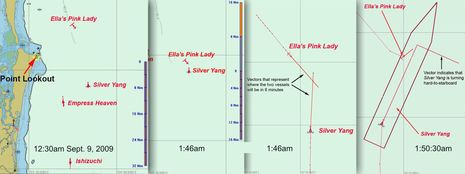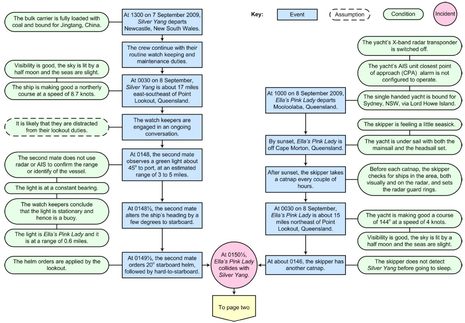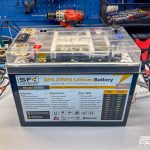Ella’s Pink Lady vs Silver Yang, DBE! #1
DBE! is my new shorthand for “Don’t Blame Electronics!” And the collision of Ella’s Pink Lady with the Silver Yang off Queensland, Australia, last September is a terrific example (especially as no one got hurt). I first heard about it in a Panbo comment focused on the “limits in detectability of Class B AIS” that the Australian Safety Board uncovered, which I’ll discuss after the break. But I sure hope that the Class B naysayers who may jump on this news actually download and read the full report first. Then they’ll know that the AIS data collected by a shore station and shown on the above chartlets (click for full size) was available on both vessels, and could have easily been used to prevent the accident…
In fact, the AIS data was apparently so good that it documented the exact moment of contact! In fact, either watch keeper could also have avoided the collision by using their radar, or just their god given eye sight! Sorry…I get agitated…but this accident is not about failed electronics; it’s about piss poor seamanship of nearly mythical proportions. Talk about negative stereotypes!
On the one hand is everyone’s worst case of a single-handed offshore sailor. The skipper of Ella’s Pink Lady was apparently cat napping at the time of the collision, in a fair amount of ship traffic, and for reasons unexplained had neither her AIS alarm nor her EchoMax active radar responder turned on. She was also in the habit of confusing herself by running her perfectly competent MFD with the chart north up and the radar head up. (Charlie Doane, incidentally, has been doing some great blogging about the teenage circumnavigation follies, as well as fantastic coverage of the Reid Stowe’s 1,152 day whatever-it-was…voyage doesn’t seem to apply.)
I feel a little sympathy for Jessica Watson just because she was 16 years old, but as for the second mate of the bulk carrier Silver Yang, not so much. The SOB did absolutely everything that gives ship drivers a bad reputation, which most of them don’t deserve. He pretty much ignored the third mate’s log entry about sighting Pink Lady just before the midnight watch change, as well as his electronic tools. He also seemed to have a poor understanding of core anti-collision viligence — i.e. watch out for anything with a constant bearing and decreasing range — and, even worse, he did virtually nothing to help Jessica after the collision. The only slightly reassuring character in this story is the master, who was on the bridge a minute after finally being called, and was apparently beside himself about the mate’s failure to avoid the accident and failure to stop and help afterward.
Now what about the “Class B detectability” issues that will probably become the most talked about aspect of the just-released report? Well, in truth, they are darn vague, mostly involving well known issues like the fact that many older Class A transponders can’t yet decipher a Class B boat’s name and other static data, though they do see its MMSI, position, COG, & SOG. But the report does reference a 2008 study of Class B performance which found that “17% of vessels fitted with Class A AIS units did not report Class B AIS detections.” Which doesn’t sound that bad to me, as I’ve never expected perfection and take comfort in the 83% of vessels that did see the Class Bs. And get this line: “The report also noted that the lack of detection issue was, to some extent, caused by vessel masters not recognising the detection on their AIS unit display.” In other words, the electronics worked, but the humans didn’t.
At any rate, the report is a good read for any boater. We learn by the mistakes of others. But I especially hope it’s read by those who want to blame Class B AIS for accidents, or even consider relying on it or any other single tool to stay safe at sea.















Hi Ben,
Good report, thank you for sharing it.
I am in Shearwater British Columbia enroute to Alaska. I have a class “B” AIS and it is wonderful. There is a lot of big ship traffic along the inside passage, and I get a lot of comfort knowing that the big guys know I am there. When there has been concerns I am quick to say I will be out of their way.
There has been some snide remarks about even little pleasure boats are getting AIS. They may be indignant about being aware of much smaller vessel, but I know that I am safer, and their arrogance shows their lack of professionalism and their lack responsibility to navigate their vessels in a prudent manner.
I am a strong believer in class “B” AIS
Patrick Harmansuwqa3
You’re living the dream, Pat, and I’m happy for you. Do you have any sense of how far away other vessels see your AIS, and how many are getting your static data (name, etc.)? Also, which Class B are you using and what is the antenna arrangement?
Hi Ben,
Yes I am living the dream. As far as range goes it is at least 6-8 miles, probably farther. The big guys have very high antennas. I have a Raymarine class B AIS. It shares a sailboat type antenna with my second VHF, It is a Shakespeare 3db 5215.
Of note they the big guys that have asked about who I am do not read my static data. They seem to get me on there AIS aware radars first and their Mapping displays a close second. I seriously want the big guys to know I am there and I listen to all the working channels in my area; 16,13, & the VTS channel. I am not afraid to call them if we have a close encounter and I don’t know their intentions or do not have a clear course out of their way. They seem to appreciate my calling them. Remember this is a remote part of the world,in New York Harbor I doubt they would be so appreciative.
Pat
While we don’t presently have a Class B transponder, we do have a receiver which is still very helpful on the busy (and occasionally foggy) Puget Sound.
We have occasionally had problems picking up the AIS signal from some large vessels when we are close in (when you most want to know where they are). Since this seems to occur most often with cruise ships and loaded container ships, I have a theory, but I’d like to hear more opinions.
We have a dedicated AIS antenna mounted to the stern rail. I didn’t want to use a splitter, and I don’t want to try mounting a new antenna with the mast up. Given the size and configuration of the disappearing ships, I suspect the geometry puts part of the ship between their antenna and ours – thus blocking the AIS signal.
If that is the case, I’m not sure if having a transponder (or even having a mast-top antenna given some of these cruise ships) would necessarily help. It’s a bit unnerving when one of those monsters is passing nearby at 18 knots and we suddenly lose track of them. I guess radar is the answer when we can afford to add it.
-Tim
Thanks, Ben, for the link to the ATSB report about the collision between Jessica Watson’s vessel (“McIntyre Adventure” of Sydmey, a.k.a. “Ella’s Pink Lady”) and the Chinese-owned, Liberian-flagged, Panamax bulk carrier (“Silver Yang” of Hong Kong).
I am refurbishing my Baba 30 sailboat with the goal of being able, eventually, to make short-handed (or even, if necessary, single-handed) ocean passages, so the report was helpful to me as I consider how to equip my own boat.
One thing I noticed is that Watson’s boat was equipped with a conventional pulse radar, with a guard zone defined by outer and inner range rings, but that she activated the alarms associated with that guard zone only when she went below to sleep — and by then Silver Yang was already within the inner range ring of the guard zone.
If she had been equipped with the new Navico BR24 “Broadband Radar”, the radar would draw less power than the conventional radar that she used, and there would have been no inner guard ring for the guard zone. In that case, if she had followed the same routine of only activating the guard zone alarm when she intended to take a nap, the alarm would have sounded.
Better yet, with the BR24’s lower power consumption, she could have afforded to leave the BR24 turned on and its guard zone activated all the time she was at sea. Even if she were to fall asleep at the wheel, rather than only after deliberately going below for a catnap, the radar’s alarm would have alerted her in time to avoid the collision.
Another thing I noticed in the report was that the inattentive and under-trained watch officer on the Silver Yang mistook the steady green light (from Watson’s tricolor at the top of her mast) for a buoy, seeming incorrectly to assume that he had only to look out for power-driven vessels. I think I will equip my vessel with high-efficiency LED navigation lights, including the red-over-green configuration at the top of my mast. (The lower current draw of the new LED navigation lights should let me afford to keep sidelights, stern light, and red-over-green lights turned on all night long.) With that lighting configuration, my boat would be less likely to be confused with a buoy, even by such an ignorant and inattentive ship’s officer.
Of course, I will also follow the ATSB’s explicit recommendations: use a passive radar reflector, orient both halves of a split-screen display the same way, etc.
James said: “If she had been equipped with the new Navico BR24 “Broadband Radar”, […] and there would have been no inner guard ring for the guard zone.”
It does have an inner guard ring setting. See
http://www.lowrance.fr/upload/Lowrance/Documents/Software_Updates/HDS_3_0_RELEASE_NOTES.pdf
Even with the radar she had, I don’t understand why the inner guard ring was set so far away. Conditions were almost ideal, it was open ocean, what was the point?
Just finished a sail from France to greece, we have a fully integrated Raymarine setup, all brand new, latest ST70, C90W and Raymarines new Class B transponder
AIS is absolulty brilliant, ours used the internal splitter and hence the standard VHF mast mounted antenna, In my opinion ITS the only way to go, We had detection out t0 30 miles plus, never missed a beat. And they saw us , you could see large ships making small course alterations ways out to ebsure they cleared us.
Its better then sliced bread folks, get a transponder today, its the best 800 bucks you can spend.
Dave
Right you are, Norse. But with the BR24, she could have set the inner guard ring really close, because she wouldn’t have to allow for the “main bang”.
Maybe she was using a compromise setting that she (or her advisers) thought would work in a variety of sea states.
It seems that neither vessel was using its available electronics effectively.
Not tested at sea yet but I went in for overkill.. fitted Garmin AIS600 class B transponder, and VHF300ais black box VHF radio with two stations, both interfaced to 5012 plotter via NMEA2000 bus. AIS600 shares a special AIS length aerial on the top spreader with the backup VHF radio via builtin splitter (the main VHF aerial is at masthead of course, 22m above the waterline).
So I have two AIS receivers.
The only issue is that the 5012 *still* has no way to register the boat’s own MMSI (as at version 5.8), so when the transponder is operating as well as the VHF300 ais feature I get an alarm I’m going to collide with myself 🙂
The 5012 also fails to report the vessel name on the alarm panel (only the MMSI is given), and doesn’t provide a way to pan to the vessel or CPA. But these are minor nits. I have AIS and VHF now even if one cable breaks or a pelican decides to roost on one aerial.
John, Have you spoken with Garmin tech support about your self alarming issue? I think it may be due to your unusual dual receiver set up. I don’t believe that it should be necessary to enter your own MMSI in the MFD to avoid self alarming, if the N2K AIS messages are formatted correctly (that was just a fix used before the message standards were completely sorted out). We had somewhat confusing discussions about this last season (and I should check it all out again), but I do know I’m not experiencing self alarming on an updated 5212 with N2K AIS input from a Raymarine AIS500.
https://panbo.com/archives/2009/08/garmin_n2k_ais_the_53_unfix_.html
Hi all,
I think that if you look a little closer you will find that she actually did have a broadband radar onboard (have a look it was still attached after the collision). Maybe if she had a pulse radar????
Well, Joe, it certainly is a Simrad radar, and the ATSB report said as much. Whether it is the BR24 broadband radar or a pulse radar is not clear. I had assumered (silly me!) that is was a pulse radar, because of the way she had configured the guard zone. But your point is well taken: it could have been the BR24.
So I have sent a query to her blog site, asking her just exactly which model of Simrad radar she had. It seems that the only way to find out is the obvious way: to ask!